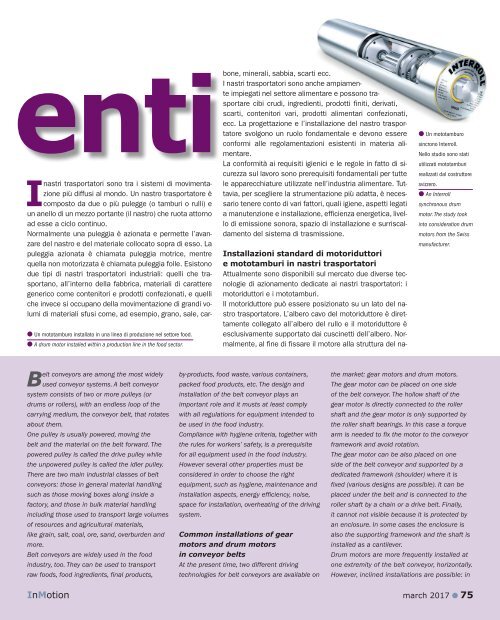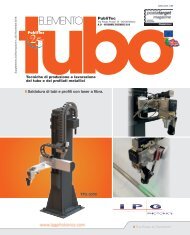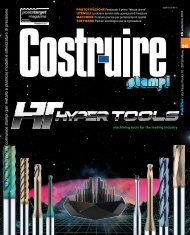PUB_INMOTION_n31_MARZO_2017_Interno96pag_160_PlanciaLR
You also want an ePaper? Increase the reach of your titles
YUMPU automatically turns print PDFs into web optimized ePapers that Google loves.
enti<br />
Inastri trasportatori sono tra i sistemi di movimentazione<br />
più diffusi al mondo. Un nastro trasportatore è<br />
composto da due o più pulegge (o tamburi o rulli) e<br />
un anello di un mezzo portante (il nastro) che ruota attorno<br />
ad esse a ciclo continuo.<br />
Normalmente una puleggia è azionata e permette l’avanzare<br />
del nastro e del materiale collocato sopra di esso. La<br />
puleggia azionata è chiamata puleggia motrice, mentre<br />
quella non motorizzata è chiamata puleggia folle. Esistono<br />
due tipi di nastri trasportatori industriali: quelli che trasportano,<br />
all’interno della fabbrica, materiali di carattere<br />
generico come contenitori e prodotti confezionati, e quelli<br />
che invece si occupano della movimentazione di grandi volumi<br />
di materiali sfusi come, ad esempio, grano, sale, car-<br />
l Un mototamburo installato in una linea di produzione nel settore food.<br />
l A drum motor installed within a production line in the food sector.<br />
bone, minerali, sabbia, scarti ecc.<br />
I nastri trasportatori sono anche ampiamente<br />
impiegati nel settore alimentare e possono trasportare<br />
cibi crudi, ingredienti, prodotti finiti, derivati,<br />
scarti, contenitori vari, prodotti alimentari confezionati,<br />
ecc. La progettazione e l’installazione del nastro trasportatore<br />
svolgono un ruolo fondamentale e devono essere<br />
conformi alle regolamentazioni esistenti in materia alimentare.<br />
La conformità ai requisiti igienici e le regole in fatto di sicurezza<br />
sul lavoro sono prerequisiti fondamentali per tutte<br />
le apparecchiature utilizzate nell’industria alimentare. Tuttavia,<br />
per scegliere la strumentazione più adatta, è necessario<br />
tenere conto di vari fattori, quali igiene, aspetti legati<br />
a manutenzione e installazione, efficienza energetica, livello<br />
di emissione sonora, spazio di installazione e surriscaldamento<br />
del sistema di trasmissione.<br />
Installazioni standard di motoriduttori<br />
e mototamburi in nastri trasportatori<br />
Attualmente sono disponibili sul mercato due diverse tecnologie<br />
di azionamento dedicate ai nastri trasportatori: i<br />
motoriduttori e i mototamburi.<br />
Il motoriduttore può essere posizionato su un lato del nastro<br />
trasportatore. L’albero cavo del motoriduttore è direttamente<br />
collegato all’albero del rullo e il motoriduttore è<br />
esclusivamente supportato dai cuscinetti dell’albero. Normalmente,<br />
al fine di fissare il motore alla struttura del na-<br />
l Un mototamburo<br />
sincrono Interroll.<br />
Nello studio sono stati<br />
utilizzati mototamburi<br />
realizzati dal costruttore<br />
svizzero.<br />
l An Interroll<br />
synchronous drum<br />
motor. The study took<br />
into consideration drum<br />
motors from the Swiss<br />
manufacturer.<br />
Belt conveyors are among the most widely<br />
used conveyor systems. A belt conveyor<br />
system consists of two or more pulleys (or<br />
drums or rollers), with an endless loop of the<br />
carrying medium, the conveyor belt, that rotates<br />
about them.<br />
One pulley is usually powered, moving the<br />
belt and the material on the belt forward. The<br />
powered pulley is called the drive pulley while<br />
the unpowered pulley is called the idler pulley.<br />
There are two main industrial classes of belt<br />
conveyors: those in general material handling<br />
such as those moving boxes along inside a<br />
factory, and those in bulk material handling<br />
including those used to transport large volumes<br />
of resources and agricultural materials,<br />
like grain, salt, coal, ore, sand, overburden and<br />
more.<br />
Belt conveyors are widely used in the food<br />
industry, too. They can be used to transport<br />
raw foods, food ingredients, final products,<br />
by-products, food waste, various containers,<br />
packed food products, etc. The design and<br />
installation of the belt conveyor plays an<br />
important role and it musts at least comply<br />
with all regulations for equipment intended to<br />
be used in the food industry.<br />
Compliance with hygiene criteria, together with<br />
the rules for workers’ safety, is a prerequisite<br />
for all equipment used in the food industry.<br />
However several other properties must be<br />
considered in order to choose the right<br />
equipment, such as hygiene, maintenance and<br />
installation aspects, energy efficiency, noise,<br />
space for installation, overheating of the driving<br />
system.<br />
Common installations of gear<br />
motors and drum motors<br />
in conveyor belts<br />
At the present time, two different driving<br />
technologies for belt conveyors are available on<br />
the market: gear motors and drum motors.<br />
The gear motor can be placed on one side<br />
of the belt conveyor. The hollow shaft of the<br />
gearmotoris directly connected to the roller<br />
shaft and the gear motor is only supported by<br />
the roller shaft bearings. In this case a torque<br />
arm is needed to fix the motor to the conveyor<br />
framework and avoid rotation.<br />
The gear motor can be also placed on one<br />
side of the belt conveyor and supported by a<br />
dedicated framework (shoulder) where it is<br />
fixed (various designs are possible). It can be<br />
placed under the belt and is connected to the<br />
roller shaft by a chain or a drive belt. Finally,<br />
it cannot not visible because it is protected by<br />
an enclosure. In some cases the enclosure is<br />
also the supporting framework and the shaft is<br />
installed as a cantilever.<br />
Drum motors are more frequently installed at<br />
one extremity of the belt conveyor, horizontally.<br />
However, inclined installations are possible: in<br />
InMotion<br />
march <strong>2017</strong> l 75





